02. Second Flag Act 1795: Official & Unofficial U.S. Flags
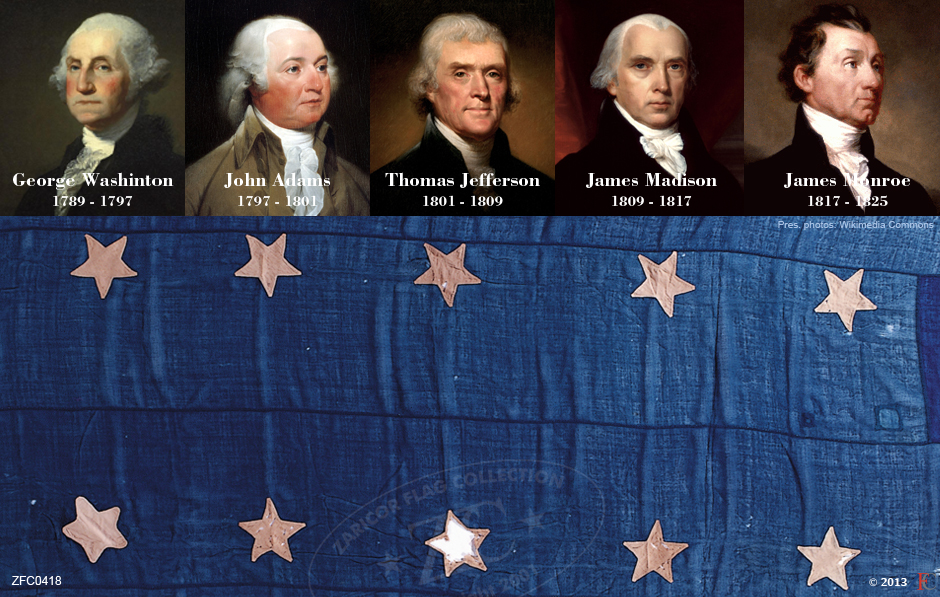
In 1795 the still nascent United States reflected the dynamic nature of the American Constitution which allowed for the admission of new states on an equal footing with those states that had created the Union. √?¬†Accordingly, in that year the Congress passed the 2nd Flag Act, which acknowledged statehood for Vermont and Kentucky and increased both the stars and the stripes on the new flag to fifteen.√?¬†
An exception to this was the flag of the U.S. Revenue Marine which like the 1790's example included here have always borne 13 stars.√?¬†Tennessee was admitted in 1803 and Ohio in 1812 as the 16th and 17th states respectively, but they were not represented on the 15 star 15 stripe flag so unofficial 16 and 17 star flags were created and flown by individuals and institutions alike.√?¬†
Included in this grouping are period 15, 16 and 17 star flags, and well as a commemorative 15 star and 15 stripes flag made in for the Centennial of the Battle of Fort McHenry Celebration of 1812-1814 which reflects both the longstanding popularity and patriotic reverence Americans have for their historic flags.
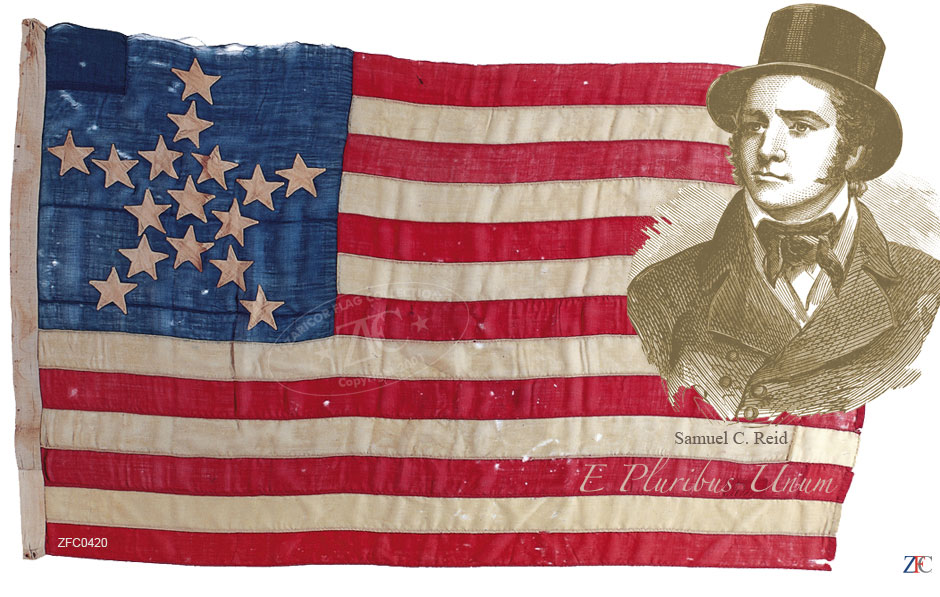
ZFC0420 - 16-Star Unofficial U.S. "Grand Luminary" Flag.
This is a 16 Star flag in the Great Star Pattern circa 1796-1808. After Vermont and Kentucky joined the Union in 1791 and 1792, Congress approved a 15-star 15-stripe flag in 1795. After that new stars officially recognized no new States until a revised law went into effect in 1818. However, that did not prevent the American public from recognizing the additions of Tennessee in 1796, Ohio in 1803, Louisiana in 1812, and Indiana in 1816 to the union and privately manufacturing United States flags of their own design. Nevertheless, there was not attempt to revise the official United States flag until 1818.√?¬†
Although no flag with 16, 17, 18, or 19 stars was ever formally adopted by Congress, the spirit of the 1794 flag resolution led numerous patrons in need of a United States flag to order one that included newly recognized states. Such flags added an extra star and sometimes a stripe to the U.S. flag of the time. This flag conforms to that spirit. The linen thread with which the flag is sewn indicates a product predating the widespread distribution of cotton thread, although the stars are cut from cotton fabric, which was not reasonably priced until after 1800. The 16 stars are arranged in the form of one great star, a design championed by Captain Samuel C. Reid in 1817. He held it to be the star pattern that would best represent the concept "E Pluribus Unum", the national motto (Out of Many, One). This is likely an early merchant ship ensign from the period 1800-1805.√?¬†
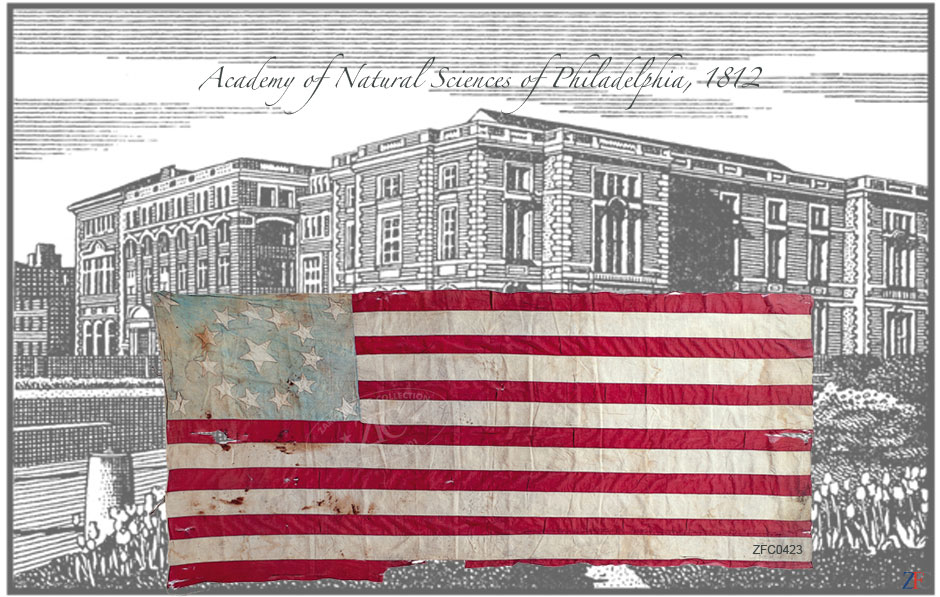
ZFC0423 - 16 Star U.S. Flag, circa 1796-1803.
After Vermont and Kentucky joined the Union in 1791 and 1792 respectively, Congress approved a 15-star 15-stripe flag in 1795. After that no new stars were added to the flag to officially recognize new states until a revised law went into effect in 1818. The idea of altering the flag created much opposition. In addition raised a dichotomy between ship owners who said that adding stars and stripes would be very costly for them, and flag makers who did not hesitate to manufacture flags like this one, with stars for all the states and sometimes with an equal number of stripes.
This unofficial 16-star flag saluted the sixteenth state, Tennessee, which joined the Union in 1796. Later there were also unofficial flags representing Ohio (1803), Louisiana (1812), and Indiana (1816). According to provenance records accompanying it, this flag was flown over the Philadelphia Academy of Natural Sciences, founded in 1812. William S. Vaux, a noted mineralogist, whose father was also associated with the Academy, supposedly had donated it to that institution. The sixteenth state, Tennessee, had joined the Union in January 1796. By the time the Academy of Natural Sciences had been formed, Ohio had also become a state (1803). It was followed by Louisiana, the eighteenth state, in 1812. It has been surmised that this may have been a Vaux family flag, predating the formation of the Academy. However, technical analysis of the sewing thread used in the construction of this flag suggests that it is unlikely that it was manufactured before1840. This raises the possibility that it is a commemorative flag possibly made for the twenty-fifth (1837), thirty-fifth (1847), or fiftieth anniversary (1862) of the founding of the Academy.
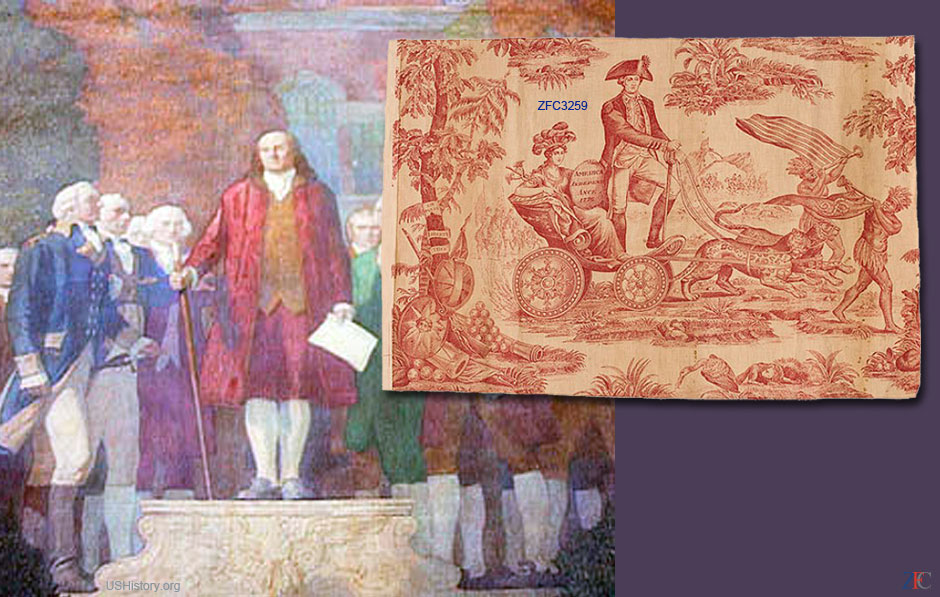
ZFC3259 - Patriotic Textile "Apotheosis of Franklin", 1785.
This textile is a memorial vignette to Benjamin Franklin from after the Revolution and is printed on fine fabric with a cotton warp and linen fill. It is printed in a rich, reddish-brown, showing George Washington in his military Generals' uniform along with Benjamin Franklin in his famous Beaver cap. Entitled: "The Apotheosis of Franklin" this textile was conceived in honor of Benjamin Franklin upon his death in 1790. Franklin holds one end of a banner, which reads, "Where Liberty Dwells, There is My Country". This textile is cherished as a classic of early Americana, and is well documented, including being listed on page 51 of the important reference work, published by the Smithsonian, "Threads of History."
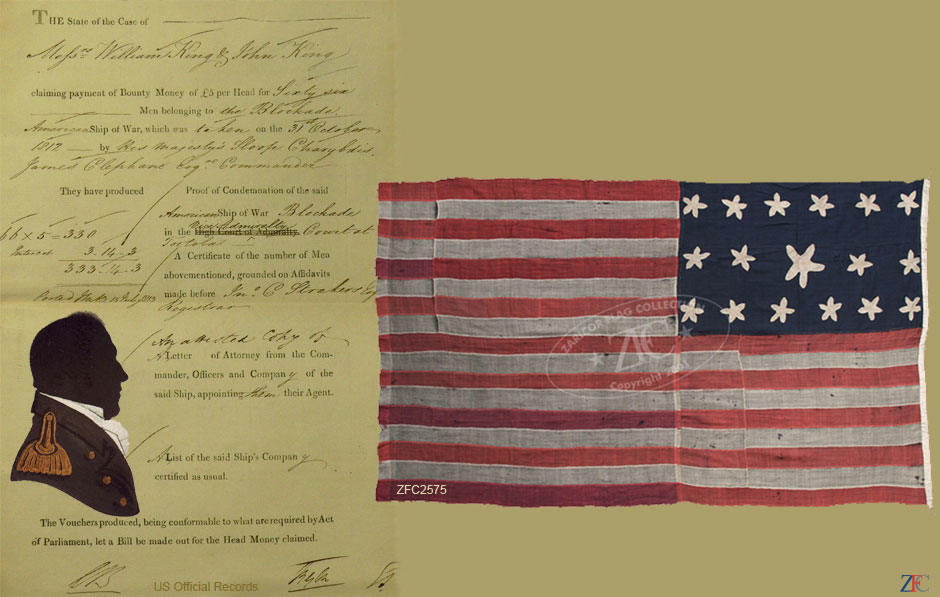
ZFC2575 - 17 Star, 17 Stripe U.S. Ensign, Privateer Blockade, War of 1812 captured by Captain James Clephan, HMS Charybdis.
This handmade seventeen-star, seventeen-stripe U.S. flag flew on the American schooner Blockade after President James Madison issued a letter of marquee on September 15, 1812, making it a privateer legally permitted to take prizes during the War of 1812. The 128-ton schooner, commanded by Captain Elisha Mix, carried about ten guns and a crew of about seventy and sailed out of Connecticut. She was captured off the island of Saba in the Caribbean on October 31, 1812 by the Charybdis, a 385-ton, eighteen-gun British navy brig with a crew of 121 commanded by Captain James Clephan (1768-1851). In the one-hour and twenty-minute battle, twenty eight officers and men of the Charybdis were killed or wounded to eight on the Blockade. The Blockade was eventually sold as a prize od war, and Clephan retained the flag as a trophy.
No other seventeen-star, seventeen-stripe flag exists in the United States. The rounded, rather than the traditional sharp pointed stars are the flag's most striking feature. The pattern of three rows of irregular stars can be traced back to the American Revolution. The stripes and the canton off the flag are made of handwoven single ply worsted wool. The stars are made of cotton and contain the numerous irregularities of handspun fabric. The reinforcing stitching on the hoist is tarred, and the entire flag bears the hallmarks of being made by either a ship's chandler or sailmaker.
The flag remains in remarkable condition because of the care it received from the Clephan family, where it remained for almost two hundred years before coming to its current owner in 2007.√?¬†
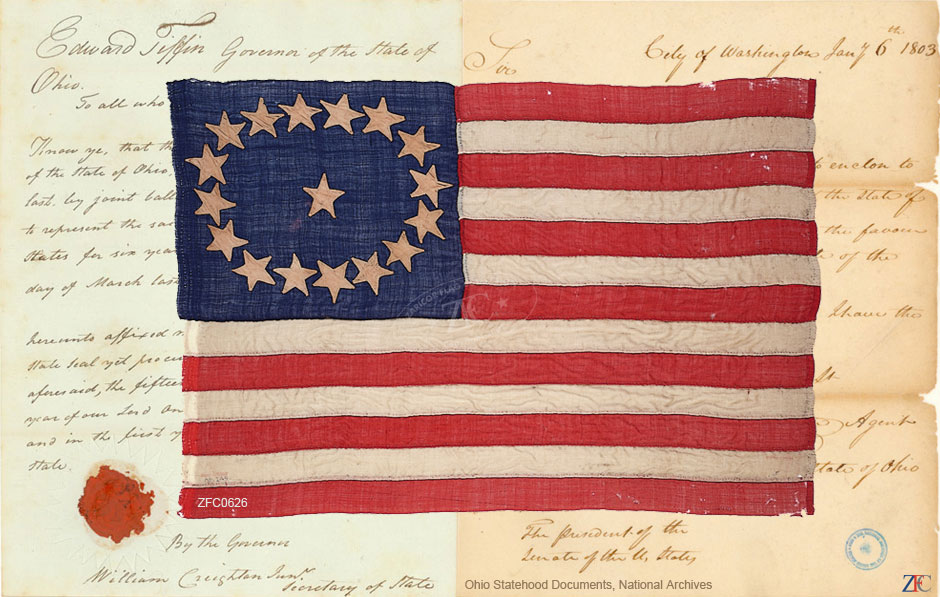
ZFC0626 - U.S. 17 Star, 17 Stripe Privateer Ensign -√?¬†Hubbard Family, 1803-1812, former Mastai Collection.
Flags bearing 17 stars and 13 stripes were never an official flag of the United States; however numerous surviving examples confirm both their existence and use. This example was made to indicate the admission of Ohio as the 17th state on March 1, 1803; and would remain accurate until the admission of Louisiana on April 30, 1812; a period of 9 years, 1 month and 27 days later.√?¬†
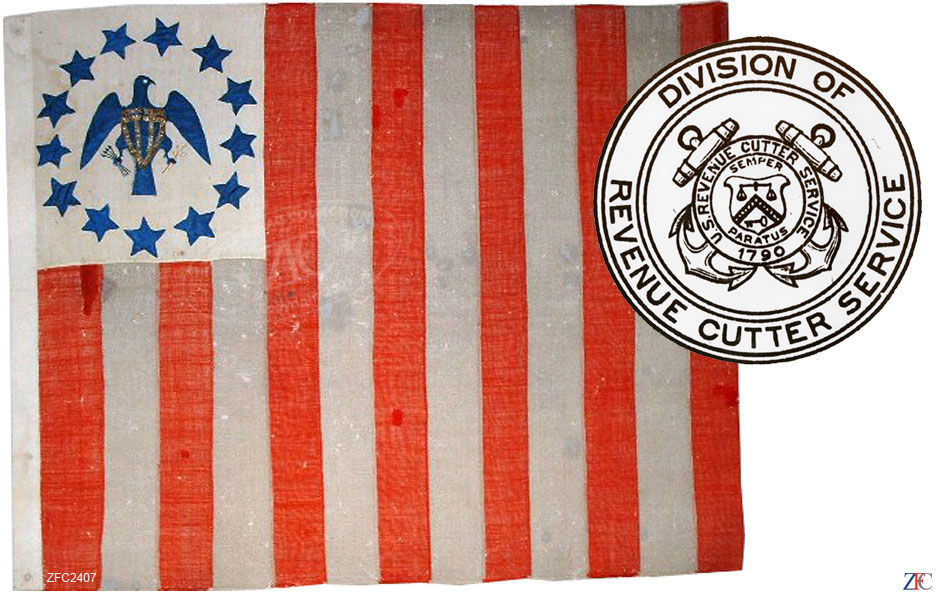
ZFC2407 - U.S. Revenue-Marine Ensign & Custom house Flag 1790s.
This flag is believed to be the oldest surviving U.S. Revenue Marine Ensign and Customhouse flag. It is hand-sewn with an open weave wool bunting for the stripes over a silk canton. In fact this flag is either a variant of the 1799 regulations of which only a letter still exist, as the original regulations were destroyed when the British burned Washington DC in 1814. Some flag enthusiasts have stated the flag is a precursor to the 1799 authorization and reflects the local flag maker's interpretation of the arms of the United States. Judging by the presence of metallic ribbon, fine embroidery details, and the use of silk threads in the canton it is unlikely that this flag was ever used as an ensign. It is more likely that this flag was flown onshore or displayed indoors at a U.S. Customs office or Customhouse.
This flag has 13 vertical stripes and is therefore not of the period of 1799 design. It is a 13 star flag from the period before the 14th state, Vermont, in 1791. The flag itself tells us it is 13 star flag from 1790/91 when the Custom Office was established as the first bureaucracy of the new U.S. Government. The U.S. Government no doubt made 13 star flags for its first revenue making department since it represented the most or only important source of income for the government (Customs Duty and Tarifs).
Later the government changed to 16 stripes to keep its unique character as a different flag from the national flag which was 15 stars and 15 stripes in 1799 when the Customs House made its flag unique by adding three stripes (total of 16 stripes) to the 13 stripe flag of 1790. So this flag is not only one of the earliest surviving flags of the young Government it is unique with its stripes vertical which kept to the idea that it must look different than the national flag. It retains the spirit of the authorized 16 stripe flag in 1790 with 13 vertical stripes. It was customary to change the flag with both stripes and stars to the appropriate number of stripes and stars to the number of states. This was not always practiced as we have seen in the flags made from 15 to 18 stripes and star flags being sometimes 16 stars and 13 stripes among other examples.
Further textile analysis would reconfirm that this was the earliest surviving 13 stripe and 13 stars bureaucratic flag of the U.S. government made at the time of the original 13 star/13 stripe flags made from 1777 to 1791. It will reconfirm ZFC's opinion this flag represents the original construction detail of the flag making it an original 13 star U.S. government flag likely made 1790/91.
The Customs Act of 2 March 1799 authorized that ships of the Treasury's Revenue-Marine would be identifiable from other government vessels with a distinctive ensign and pennant. This task went to Alexander Hamilton's successor Oliver Wolcott. His design was ultimately approved by President John Adams and the first official Revenue-Marine flags were authorized in 1799, perhaps based on this very flag. Wolcott's proposal featured an ensign of sixteen vertical stripes of alternating red and white. Although Secretary Wolcott created a service-wide ensign it was the responsibility of each collector of customs to make local arrangements for the furnishing revenue cutter ensigns.
The flag was initially intended as a ship's ensign for Revenue-Marine cutters the Collectors of Customs soon were flying it over their customhouses. There would be no standardization in the manufacture and issue of this flag until the American Civil War; prior to 1862 each Collector of Customs was responsible for acquiring flags for their districts use.√?¬†
√?¬†
2nd Flag Act 1795: Official & Unofficial U.S. Flags Grouping
| Item Ref | Item Name | Sub-Collection | |
 |
ZFC2407 | US Revenue-Marine Ensign & Custom House Flag 1790s | U.S. Goverment |
 |
ZFC0418 | U.S. 15 Star Union Jack - Merchant ship Vineyard. | Flayderman // Early American |
 |
ZFC3259 | Patriotic Textile "Apotheosis of Franklin", 1785. | U.S. Political |
 |
ZFC0420 | U.S. 16 Star Flag - Grand Luminary "Peoples Flag". | Flayderman // Early American |
 |
ZFC0423 | U.S. 16 Stars - Academy of Natural Sciences. | Star Spangled Banner Flag House |
 |
ZFC2575 | U.S. 17 Star, 17 Stripe Privateer Ensign. | Napoleonic Wars & War of 1812 |
 |
ZFC0212 | Declaration of Independence Commemorative Print. | de Young Museum |
 |
ZFC0626 | U.S. 17 Stars, 13 Stripes Flag - Hubbard Family. | Mastai - Early American Flags |
 |
ZFC5035 | US // 16 Star Flag Pin / ZFC0420 | Flag Center |
CONFIDENTIALITY NOTICE: This Website, and any contents or web pages attached may contain confidential information, including information that is legally privileged. You are hereby notified that any entry into this site or disclosure, copying, distribution or use of any of the information contained in or attached to this site is strictly prohibited. If you have any knowledge of attempts to enter this site wrongfully, please immediately notify us via e-mail or phone. This system contains privileged and confidential information and is intended for the exclusive use of Zaricor Flag Collection ("ZFC") personnel and our clients. Only authorized ZFC personnel or specifically authorized clients are permitted access to this system. Any unauthorized use of this system is unlawful, and may be subject to civil and/or criminal penalties. All access to this system is monitored and may be used as evidence in court. If you are uncertain of your authorization status please contact us.

